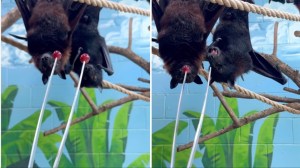The Santa Cruz Patch reports that researchers at the University of California Santa Cruz have taught one of their resident sea lions, Ronan, how to keep a beat. In this video, you can see her bopping her head to “Boogie Wonderland” by Earth, Wind & Fire and other funky songs. Peter Cook of the University’s Pinniped Cognition and Sensory Systems Laboratory confirms that Ronan is the “first non-human mammal shown able to find and keep the beat with musical stimuli” which “challenges earlier evidence from humans and parrots suggesting that complex vocal mimicry is a necessary precondition for flexible rhythmic entrainment.” According to the University’s Newscenter, Cook is the first author of the study which was published online April 1, 2013 in the Journal of Comparative Psychology (pdf).
The capability to synchronize movement to a steady beat (called “sensorimotor synchronization”) is a behavioral capability once thought to be unique to humans. Recently, this ability has been identified in a few other species, most notably the sulfur-crested cockatoo. Previously, this ability had only been shown in animals demonstrating vocal mimicry. Due to this, it has been suggested that sensorimotor synchronization to rhythmic stimuli could be a byproduct of evolutionary adaptations supporting complex vocal learning. In order to explicitly test this hypothesis, graduate student Peter Cook and researcher Andrew Rouse have trained and tested sensorimotor synchronization in a vocally stereotypic mammal: the California sea lion. Thus far, the sea lion subject has learned to reliably synchronize a continuous head bob to click tracks of different types and tempos. She has also transferred this behavior to new tempos and sound types. Most recently, she has successfully demonstrated the ability to synchronize her movements with music. These results confirm that a vocally inflexible animal can learn to flexibly synchronize motor behavior to external auditory stimuli and present a strong challenge to the supposed primacy of vocal mimicry.
Thanks Kevin!






